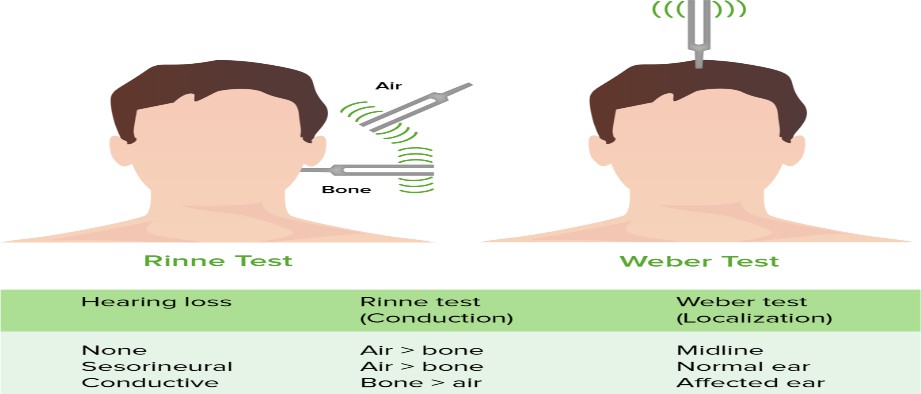A nurse is conducting the Weber's test on a client. Which of the following is an appropriate action for the nurse to take?
Deliver a series of high-pitched sounds at random intervals.
Whisper a series of words softly into one ear.
Place an activated tuning fork in the middle of the client's forehead.
Hold an activated tuning fork against the client's mastoid process.
The Correct Answer is C
C. This procedure helps assess the conduction of sound through bone to both ears, which can indicate whether hearing loss is conductive or sensorineural. The sound should be heard equally in both ears if hearing is normal. If there is unilateral hearing loss, the sound will be heard better in one ear.
A. Not part of the weber’s test
B. Not part of the weber’s test D. Described the Rinne’s test

Nursing Test Bank
Naxlex Comprehensive Predictor Exams
Related Questions
Correct Answer is B
Explanation
B. Trochanter rolls are positioning devices placed alongside the hips and thighs to prevent external rotation of the legs, which can lead to hip dislocation or pressure injuries. Using trochanter rolls helps maintain proper alignment of the lower extremities and reduces the risk of musculoskeletal complications.
A. Crossing the client's ankles when lying supine can increase the risk of pressure injuries, particularly over bony prominences such as the ankles, and impair circulation.
C. Placing the client's arms at their side is not typically recommended as it does not facilitate proper body alignment and can lead to discomfort.
D. Logrolling the client every 4 hours is a technique used for clients with spinal injuries or after certain types of spinal surgery and may not be necessary for all immobile clients.
Correct Answer is ["B","C","D"]
Explanation
B. Using grab bars when getting in and out of the bathtub helps prevent slips and falls, especially in wet or slippery conditions. This is an important safety measure, particularly for individuals with mobility issues or who are at risk of falling.
C. Having a fire escape plan with the family is crucial for preparedness in the event of a fire emergency. This includes identifying escape routes, practicing fire drills, and designating a meeting place outside the home. Having a plan can help ensure everyone's safety in case of a fire.
D. Checking medications for expiration dates is essential to ensure their effectiveness and safety. Expired medications may be less potent or could have potentially harmful effects. Discarding expired medications and obtaining new prescriptions as needed helps prevent medication errors and adverse reactions.
A. Applying tape over frayed areas of electrical cords is not a safe practice and can pose a fire hazard. Frayed cords should be replaced immediately to prevent electrical shocks or fires. Therefore, this statement does not indicate an understanding of home safety.
E. Setting the hot water heater to 140 degrees Fahrenheit (Choice E) is not recommended as it can pose a scalding risk, especially for young children and older adults with sensitive skin. The recommended
temperature for hot water heaters is typically around 120 degrees Fahrenheit to reduce the risk of scalds while still providing hot water for daily use. Therefore, this statement does not indicate an understanding of home safety.
Whether you are a student looking to ace your exams or a practicing nurse seeking to enhance your expertise , our nursing education contents will empower you with the confidence and competence to make a difference in the lives of patients and become a respected leader in the healthcare field.
Visit Naxlex, invest in your future and unlock endless possibilities with our unparalleled nursing education contents today
Report Wrong Answer on the Current Question
Do you disagree with the answer? If yes, what is your expected answer? Explain.
Kindly be descriptive with the issue you are facing.
